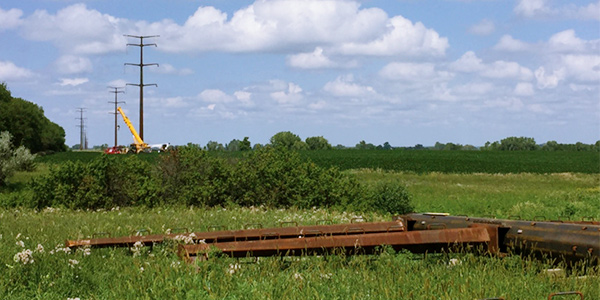The team behind the CapX2020 transmission study is reuniting again for an effort that looks ahead to 2050. But this time around, the Minnesota utilities grouped behind the project will focus on decarbonization goals rather than reliability needs.
Furthermore, the CapX2050 Transmission Vision study will look beyond transmission for possible solutions, the companies say.
Spearheaded by Great River Energy and Xcel Energy, the new effort will rely on the combined internal resources of 10 Minnesota utilities, said Great River Energy Director of Transmission Planning Gordon Pietsch, the study’s co-lead.
“What we’re doing is trying to address impacts on Minnesota and the region going carbon-free,” Pietsch said in an interview with RTO Insider.
“Like the Blues Brothers, [we] are on a mission to put the band back together again, and we are working with the original CapX2020 utilities that built over $2 billion of transmission projects in the Upper Midwest over the last 10 years,” Xcel Energy CEO Ben Fowke told analysts during an Oct. 24 third-quarter earnings call. (See Xcel Talks Tx Build After Earnings Come up Short.)
While CapX2020 was driven by local and regional reliability needs and renewable portfolios standards, the new study will focus on generation retirements, renewable additions, inverter-based issues and any foreseen reliability and stability impacts resulting from the growing dominance of renewables. As Fowke noted, CapX2020 culminated in an 800-mile, grid expansion in the Upper Midwest, including four 345-kV transmission lines in Minnesota, North Dakota, South Dakota and Wisconsin and a 230-kV transmission line in northern Minnesota.
If the study’s objective seems vague, that’s the point, Great River Energy executives said. There’s not a definitive timeline, any potential project ideas or specific geographic areas of focus. The utilities stress that they’re not foreclosing any potential solutions, which aren’t limited to transmission projects.
Great River Energy Chief Transmission Officer Priti Patel said that while she couldn’t definitively say how long the study might take, now is the time to “begin the discussion around operating challenges that might arise as we move to a decarbonized future.”
Over time, she said, project needs will come into focus.
Pietsch said the study could yield not only transmission projects but needs that other technologies can address.
“We don’t know what those technologies will be yet, but the system that we operate today will be much different in a carbon-free future,” he said. “Transmission planning is imperative as utilities move to non-dispatchable generation.”
Pietsch said the study will “articulate the challenges we’ve seen on the system today and how they might be different in the future.” That work will include a look at grid needs under escalating weather events, he said. The study will also examine power flow, system stability, short-circuit current availability and other operating issues.
No Quick Fixes
The CapX2050 study will study Minnesota, eastern North Dakota, eastern South Dakota, western Wisconsin and the surrounding areas to identify potential constraints. Patel said the utilities will share their findings with regulators, lawmakers and the public. She said the utilities would also put results before MISO planners, if necessary.
“It may not come as a surprise that some of our issues might be indicated in the MISO study work as well,” Patel said, referencing the RTO’s ongoing renewable integration impact assessment.
“We want to say, ‘Here’s what we’ve learned about going carbon-free,’” Pietsch said.
Fowke said the need for new transmission is illustrated by NextEra Energy’s Crowned Ridge wind project in northeastern South Dakota having to be scaled back by 100 MW because of increased MISO interconnection upgrade costs. He said Xcel had planned to assume control of 100 MW from Crowned Ridge as a build-to-own transfer project. NextEra’s decision to reduce the capacity “highlights the need to expand transmission investment to address congestion and ensure the viability of future renewable projects,” he said.
“The work we did with CapX2020 opened up the door for a lot of renewables, but [the system] is starting … to get constrained. And I do think long-term, we are going to need more transmission development in the region to make sure we can continue to see renewables come into the MISO market,” Fowke said.
Xcel CFO Bob Frenzel cautioned that it’s still “early days” for the CapX2050 vision study.
“I don’t think this is a very quick process. I think this is going to take at least five years through planning before we start getting into real capital plans and construction time frames,” Frenzel said. “So I don’t want to suggest that something is going to change in the next year … in terms of congestion in the MISO region. And we are seeing similar stuff in SPP as well in terms of just congestion and queues being backed up and projects being assessed with significant upgrade costs.”
But it’s clear to the group that 2050 will be a watershed year for clean energy. Minnesota Gov. Tim Walz has called for 100% carbon-free electricity in the state by 2050. Xcel similarly has a plan to go carbon-free by then.
“I would say that we choose 2050 because that’s what we’ve heard,” Patel said.
CapX2050’s other participating utilities include Central Municipal Power Agency, Dairyland Power Cooperative, Minnesota Power, Missouri River Energy Services, Otter Tail Power, Rochester Public Utilities, Southern Minnesota Municipal Power Agency and WPPI Energy.





